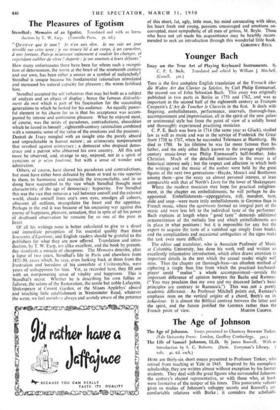Younger Bach
Essay on the True Art of Playing Keyboard Instruments. By C. P. E. Bach.
Translated and edited by William J. Mitchell, (Cassell. 3os.)
THIS is the first complete English translation of the Versuch abet. die Wahre Art das Clavier zu Spielen, by Carl Philip Emmanuel, the second son of John Sebastian Bach. This essay was originally
published in two parts in Berlin in 1753 and 1762, and was as
important in the second half of the eighteenth century as Francois Couperin's L'Art de Toucher le Clavecin in the first. It deals with fingering, embellishments, performance, intervals, thorough-bass, accompaniment and improvisation, all in the spirit of the new galant or sentimental style but from the point of view of a solidly based and thoroughly experienced practising. musician.
C. P. E. Bach was born in 1714 (the same year as Gluck), studied law as well as music and was in the service of Frederick the Great
from 1738 to 1767, when he succeeded Telemann at Hamburg. He
died in 1788. In his lifetime he was far more famous than his
father, and the only other Bach known to the average eighteenth-
century music-lover was Philip Emmanuel's half-brother, John Christian. Much of the detailed instruction in the essay is of historical interest only ; but the respect and affection in which both
the writings and the music of the author were held by the great figures of the next two generations—Haydn, Mozart and Beethoven among them—give the essay an almost personal interest, at least comparable with that of North's Lives for the lover of Shakespeare. Where the modern musician may hope for :practical enlighten- ment, in the chapter on embellishments, he will perhaps be dis- appointed.
turn,
slide and snap—were more truly embellishments in German than in French music, where the agrements formed an integral part of the
music and were less left to the individual taste of the performer.
Bach explains at length where " good taste " demands additional ornamentation of the melodic line and which embellishments are in place in. what positions ; but it is, impossible-for any but the expert to acquire the taste of a vanished age_ simply from books, and the compliCatiotis and occasional ambiguities of the 'signs make
the task even More difficult. • - The editor and translator, mini is Associate ProfessOr of Music
at Columbia University: has done his work well and written an excellently-informative introduction, which often draws attention to important details in the text which the casual •reader might well miss. Thus the chapter on thorough-bass—an obsolete method of ciphering a single bass line from Which the practised keyboard- player could " realise 7' a whole'. accompaniment—Keveals the important difference of opinion between the Baths and Rameau. (" You may -proclaim that my own and my deceased father's basic principles are contrary to Rameatk'S.") This was -.not a purely academic difference. , As ProfessorMitchell points out, Rameau's emphasis rests on the vertical origins of a chord, Bach's on its behaviour. It is almost the Biblical contrast between the letter and
the spirit, and the future justified the German rather than the
French point of view. MARTIN COOPER.






































 Previous page
Previous page